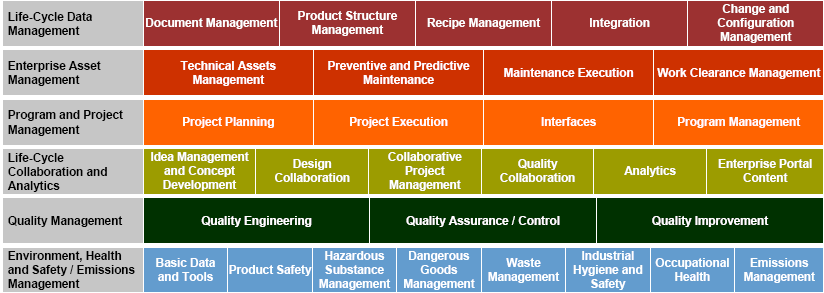Is SAP PLM for Real?
Executive Summary
- How SAP has been busy pushing a solution that does not exist as a distinct product.
- An analysis of SAP PLM.

Pushing SAP PLM
For some time, SAP has been promoting its product lifecycle management (PLM) solution. PLM is a problematic term that more than a few companies have had a problem defining.
Notice of Lack of Financial Bias: We have no financial ties to SAP or any other entity mentioned in this article.
- This is published by a research entity, not some lowbrow entity that is part of the SAP ecosystem.
- Second, no one paid for this article to be written, and it is not pretending to inform you while being rigged to sell you software or consulting services. Unlike nearly every other article you will find from Google on this topic, it has had no input from any company's marketing or sales department. As you are reading this article, consider how rare this is. The vast majority of information on the Internet on SAP is provided by SAP, which is filled with false claims and sleazy consulting companies and SAP consultants who will tell any lie for personal benefit. Furthermore, SAP pays off all IT analysts -- who have the same concern for accuracy as SAP. Not one of these entities will disclose their pro-SAP financial bias to their readers.
Analyzing SAP PLM
When I perform an analysis of SAP PLM for a client, I learned that SAP PLM was not an actual product but was, in fact, a “solution.” He means that various pre-existing modules have been created around the material master to meet PLM requirements. This is much like SAP’s non-existent digital asset management solution – where digital media are entered as materials into SAP. Digital asset management and PLM have a lot in common because both solutions require much functionality regarding multi-media files.
For PLM, these files take the form of images and schematics, while in digital asset management, the files take the form of images, music, and video. However, the material master functionality in SAP is not designed to manage these files or make them easy to find or reference. There is no big surprise, why. The material management functionality was intended to hold textural data on products for accounting and supply chain management. Changing this functionality around to meet the needs of asset and document management is no easy task. When one goes through the BOM functionality and compares it to a real BOM management solution, the difference is like night and day.
Problems with Managing Changing Materials in SAP ERP
If a company changes their material masters and has SAP ERP, they have maintenance problems. SAP ERP has limited methods for making adjustments to materials. The consequence is that new elements are created as copies of old materials, and the old materials have no real way of being connected to the new materials.
The overall maintenance problems with SAP mean that no longer or little-used materials clog up the system. This severe limitation for material master management was one of the motivations for bringing out SAP PLM. However, instead of bringing out a new “product,” SAP should have just addressed the underlying material management functionality of the existing software their customers had already purchased. They, of course, did not do this. However, while the BOM management is one part of PLM, the solution from SAP is much more encompassing than just BOM.
Lifecycle Planning in APO
The confusing part about PLM, which SAP does not adequately explain, is that SAP lifecycle planning exists in the supply chain planning suite offered by SAP. For instance, in Demand Planner, the forecasting module of SAP APO, lifecycle planning is incorporated. DP allows you to introduce an existing product at a different location – using profiles to base historical data from current locations. Phase in profiles enables the reduction of the forecast for the period of introduction. (more details)
However, this capability in SAP DP and the product interchangeability functionality available in other modules of the APO suite (notably SNP, CTM, PPDS, and GATP) is quite a bit different from the integrated SAP PLM solution that SAP presents to clients. Again, this gets back to the SAP PLM solution’s problem, confusing messaging from SAP and functionality, which is PLM related but does not exist within the official SAP PLM solution. PLM functionality can exist in different areas of supply chain applications. However, it does not mean that the answer is offering an excellent bill of material management functionality which includes:
- Multimedia file management
- Document management
- Engineering change management
- Collaboration management (between marketing, engineering, and production)
SAP Has Had Its Shot in PLM
SAP PLM has not taken off, and it does not appear to be an area they have or intend to put real development effort behind. However, they still make their white papers available on the topic. SAP’s entry into the PLM market’s main effect has been to discourage companies from implementing real PLM solutions and damaging the PLM’s image more generally due to SAP’s problems in bringing SAP PLM to live on accounts. Part of this is due to the solution’s limitations, but then another part is related to SAP’s positioning and messaging in the solution.

You can see one of the main graphics for SAP PLM (listed under Life-Cycle Data Management at the top). However, a major flaw in this diagram is apparent. PLM is based upon document management, but SAP does not have any serious document management capability. The best evidence of this is SAP Solution Manager’s state that is causing project heartburn on SAP projects globally.
PLM and Service Parts
PLM is, of course, imperative for service parts. Many of the service parts planning applications have built-in control fields in the form of things like shelf life, and of course, supersession is a manifestation of product lifecycle needs (out with the old – in with the new). While researching PLM for service parts, I came upon a company called Arena Solutions, and I have tested their software extensively. I think it’s time more companies gave it a try. It is effortless to use, offers hosted solutions, and has tons of PLM functionality.
I have, over time, interacted with Arena Solutions and always come impressed with their solution and their people. I have written a series of articles and video interviews with them. You can find these articles at this link. However, the market is mostly immune to such information and continues to believe SAP offers a solution where it has none and cannot use “real” answers because they don’t have a major brand name attached.
PLM and PDSs
SAP has an object in SAP APO called the Production Data Structure (PDS) that proposes to have PLM capabilities and ties with the rest of SAP’s “PLM” functionality. However, as companies do not use SAP for PLM, it makes little sense to use the PDS. However, SAP still advises using this object on projects. Read about SAP’s message to clients in this post.
Conclusion
SAP has some disadvantages when it comes to competing in the PLM market. One is that the material master is not an active object for BOM lifecycle management. The material master lacks the functionality and is extremely far behind the best of breed Arena Solutions in all functionality related to change and collaboration. Attempting to bring lifecycle capabilities and collaboration to the material master functionality is stretching it beyond its original design.
Secondly, SAP’s messaging is confusing and does not consider the PLM functionality that is distributed throughout many applications, including SAP APO/SCM, but without explaining how it leverages them or even interacts with them. Many analysts who write in the PLM/BOM management space seem to have no idea about the subject matter and cannot help clients differentiate quality solutions from vaporware.
In summation, PLM is a very high-risk solution, and implementation and companies evaluating it must be extra careful to check what is there.
Update
Since this article was written, SAP has attempted a reboot of its PLM solution. This article is still relevant to read because, in many ways, things have not changed. However, to read the latest on this topic, see this post.
References
*https://www.amazon.com/Sales-Inventory-Planning-SAP-APO/dp/1592291236